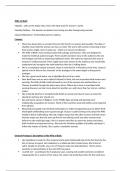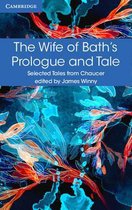Wife of Bath
Virginity - Links to the Virgin Mary, this is the ideal state for women = purity.
Chastity/Celibacy - The decision to abstain from having sex after having being married.
Chaste Widowhood - Preferential state for widows.
Context:
There has always been a constant focus by the church on women and sexuality. The idea of
chastity means that the woman can focus on God. The worry with women remarrying is that
time women might come to enjoy sex - which is of course not allowed.
The Wife of Bath's Tale would provoke both outrage and humour. They are designed to
make the medieval audience laugh. There would have been many in the audience who see
the Prologue and Tale as endorsing traditional values. She comes to represent the vices of
women in medieval period. There might have been women in the audience who would fully
understand and recognise the male behaviour that she is talking about.
She is a completely unique character, there is none like her in literature at the time. Chaucer
spends a lot of time on her character as her prologue is the same length as the general
prologue.
She has a good social status, she is identified first of all as a wife.
Near Bath there was an area called St Michael’s Parish, this was associated with women and
weaving, The Wife of Bath could be based on one of the women who worked there, as
Chaucer travelled through this place many times. Where she is from is associated with
weaving however we hear more about her position as a wife more than her role as a clothes
maker.
She is literally deaf but is metaphorically death to society and church views on what she
should do and how she 'should' act.
Eap and Gaunt, places in Belgium. In the Middle Ages weaving and spinning were
traditionally occupations for women. Much of the countries wool and clothes were imported
from abroad.
Edward III persuaded many Flemish clothmakers to settle in England because he didn't think
that English clothmaking wasn't good enough. Chaucer could be being ironic about the Wife
of Bath's skill at clothmaking. She had a higher status than the other women and that meant
that she made sure that she went up first for the offering and if any other woman went
before her she would get angry. She is a woman who likes to assert her power and status,
both of which are important to her. She lacks the Christian qualities of humility and doesn't
follow the mantra of charity. She is quite a combative woman.
General Prologue’s description of the Wife of Bath:
Her headdress is made of a fine material and is quite fashionable due to the fact that she has
lots of money to spend. Her headdress is so elaborate that it looks heavy, this is kind of
satire. Deadly sin of pride, also a sin of trying to make one look attractive - this to clerics
would be a representation of Eve who fell from grace.
'scarlett red' - according to the Sumptuary Laws, wearing red would have been considered
inappropriate for a woman of her status, the colour red would have been for the royal class.
, Red was a very expensive dye and because she is quite rich she is able to obtain clothes this
colour. The red is also associated with passion, lust and seduction.
'bold' - she is a confident woman, her face is red implies that she drinks a lot. Nonetheless
she has a healthy complexion.
'worthy' - her worth is not moral because she has had five husbands, rather her worthy if
that of a financial status.
During the 10th-16th century marriage was a two part ceremony; first part takes place at the
Church door and make their pledge to each other with witnesses around them, then there
would be a marriage mass. In this ceremony the husband would have to legally agree to
protect their wives financially. The fact that the Wife has had five husbands implies that she
has accumulated a lot of wealth.
The Wife of Bath is quite keen on men because she also had relations in her youth before
her five marriages.
Her independence is highlighted by the number of places she has been to on pilgrimage, this
also highlights her financial independence.
'wandering by the way' - saying that the Wife of Bath doesn't follow the straight path, she
likes to explore and digress from the main place or point in her storytelling. Not only can she
not keep on the right path morally but her narration also wanders from the main point.
'Gat toothed' - this meant that one was lustful and faithless and irreverent (disrespectful).
Chaucer is giving suggestions about her character before she tells her story.
Her hat is as wide as a small shield (links to 'spurs'), these images of battle shows that this
woman is quite aggressive and combative, she is in no way passive or submissive to anyone,
especially not men.
Her big hips are supposedly quite sexual and seductive, also a sign of a healthy lifestyle.
Suggests that she is quite versed in the art of love, 'remedies' - she would know all about
aphrodisiacs and how to prevent children. 'dance' - could be a euphemism for sex and that
implies that she knows a lot about love and sex.
Prologue to the Wife of Bath's Tale:
'my jolly body' - her personal experience of being a woman is pitted against the authority of
the church and the male clerics.
Her tale will make the company sit up and have fun, laugh.
Her take won’t include morals and philosophy.
It’s not going to be scientific and there will be no reference to the law and the order of
society - not going to be educational or academic, not going to teach about worldly things
rather about being a woman.
Allison is going to pit knowledge and writing (church fathers and textual authorities) against
speaking (experience and the body), these two ideologies are going to be constantly in
opposition. She wouldn't have been educated in textual matters, rather she is
knowledgeable in the experiences of the body and is therefore challenging the church
authorities on their perceptions of women and how women should act and she is constantly
challenging the authority of the Bible and often reinterprets the Bible in her own ways.
'Experience, thogh noon authoritee' - Syntactically placed at the beginning, her tale is all
about the experience of being a woman ('my jolly body'). Le Roman de la Rose (The
Romance of the Rose)- in which there is a La Vielle (a hag) who also refers to experience (of
being a woman), so Chaucer is alluding to this text.





